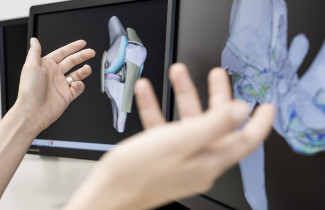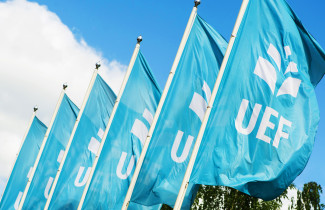ABSTRACT
Knee joint ligaments are soft tissues connecting the femur to the tibia, transmitting forces, restricting movements and stabilizing the joint. The patellar tendon (PT) connects the patella to the tibia, transmitting the force generated by the quadriceps muscle to enable extension of the knee. It is not well known how the biomechanical and biochemical properties compare between these tissues and how the biochemical composition is related to the biomechanical properties. Additionally, material models of ligaments distinguishing fluid, matrix and collagen fibers, are inherently limited in their representation of viscoelastic properties. Therefore, the aims of this thesis were to comprehensively characterize and compare the biomechanical and biochemical properties of knee ligaments and PT, to elucidate their structure–function relationships, and to develop a fibril-reinforced poroviscoelastic composite material model for accurate representation of ligament tissue.
Dumbbell-shaped tensile testing samples were cut from the midsubstance of four bovine primary knee ligaments and patellar tendon (n=10 knees). The samples were subjected to a tensile stress-relaxation test, a sinusoidal loading test and an ultimate test until tissue failure. Water, hydroxyproline (collagen), uronic acid (proteoglycan) and elastin contents were biochemically determined. Multiple linear regression was used to investigate the relationship between biochemical composition and biomechanical properties. Data from 10 anterior cruciate ligament (ACL) samples were averaged and used to create a finite element model of the relaxation experiment. Existing and new poroelastic and fibril-reinforced poroviscoelastic models were implemented to replicate the experimental force-time curve.
The lateral collateral ligament (LCL) had a higher phase difference compared with other ligaments and patellar tendon at 0.5 Hz loading frequency (p<0.05). Medial collateral ligament exhibited the highest Young’s modulus, strain-dependent modulus and toughness (p<0.05 compared with ACL, LCL and PT) and also the highest collagen content. Collateral ligaments had lower uronic acid contents compared with cruciate ligaments (p<0.05), and the elastin content was higher in posterior cruciate ligament as compared with ACL (p<0.05). The uronic acid content significantly predicted Young’s modulus, yield stress and toughness, whereas the elastin content was related to toe region nonlinearity and Young’s modulus. Previous fibril-reinforced poroviscoelastic models were unable to completely reproduce the complex relaxation behavior (R2=0.815-0.976) while the new model with the two-relaxation-time strain-recruited viscoelastic fibrillar network developed in this thesis captured well the experimental observations (R2=0.997).
The differences in the biomechanical and biochemical properties highlight the adaptation of tissues to specific physiological functions, anatomical restrictions and loading regimes. Specifically, the LCL was the most viscous at low-frequency loads, while the MCL was the stiffest, whereas cruciate ligaments had the highest proteoglycan content. Proteoglycan and elastin contents being significant predictors of important biomechanical properties may indicate that they have crucial functional roles in ligaments and tendons, possibly influencing load transfer within the tissues. The modeling results indicate that the fast and slow viscoelastic phenomena should be incorporated into the fibrillar network formulation. The novel fibril-reinforced poroviscoelastic material model may be applied for ACL, and probably also for other ligaments, for an accurate representation of these tissues in models of the whole knee joint.
The doctoral dissertation of MSc (Tech.) Aapo Ristaniemi, entitled Structure and function of knee ligaments and patellar tendon: Biomechanics, biochemistry and computational modeling will be examined at the Faculty of Science and Forestry on the 3rd of July (online). The opponent in the public examination will be Professor Hazel R. C. Screen, Queen Mary University of London, UK, and the custos will be Professor Rami Korhonen, University of Eastern Finland. The public examination will be held in English.


